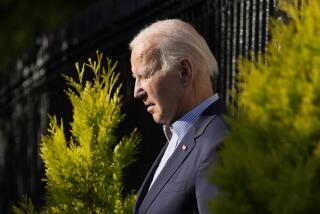Eisenhower Memorial Site Is Selected in Washington
- Share via
WASHINGTON — Dwight D. Eisenhower had been dead for more than a decade before scholars began calling him one of the greatest presidents in American history.
Now planners have chosen one of Washington’s most prominent sites for a grand memorial to the humble man from Abilene, Kan.
The plaza-style memorial across the street from the National Mall would honor Eisenhower’s legacy of public service, joining the collection of monuments to Washington, Jefferson, Lincoln and Franklin Delano Roosevelt.
“It was his total approach to domestic and international politics that set him apart,” said Retired Air Force Brig. Gen. Carl Reddel, executive director of the Eisenhower Memorial Commission. “He’s a much more profound figure than many realized.”
The memorial site, selected earlier this year, was approved this month by the National Capital Memorial Advisory Commission.
If it passes muster with two other advisory groups, the commission will formally recommend it to Congress next year.
Completion of the memorial remains at least five or six years away, Reddel said. There is no design yet, although planners envision both a physical structure and a “living element” that would offer programs explaining Eisenhower’s role in history.
Although many remember Eisenhower as the general who launched the D-Day invasion of France and led the Allied forces to victory in World War II, the memorial plans to focus on the unheralded accomplishments of his two presidential terms from 1953-1961.
“He kept the peace during the Cold War,” said Dan Holt, director of the Eisenhower Presidential Library and Museum in Abilene. “Most people don’t understand how difficult that was in the 1950s.”
The Republican remained popular throughout his presidency, but when he left office, historians dismissed him as timid and indecisive. His reputation began to grow in the early 1980s, after the publication of several influential books revealed the “hidden-hand” style of governing behind the folksy demeanor.
“Ike had a management philosophy that if you take sides on major issues publicly, you polarize both those who support you and those who are against you, so he tried to stay in the middle,” Holt said.
Eisenhower was criticized, for example, for not publicly condemning Republican Sen. Joseph McCarthy during his communist witch hunts in the early 1950s. Archives later revealed the president’s secret campaign to undermine the Wisconsin senator.
On the domestic front, Eisenhower was the driving force behind the Interstate highway system and helped push through the first two civil rights acts since Reconstruction. In 1954, he made it clear he would enforce the Supreme Court’s ruling in Brown vs. Board of Education by sending National Guard troops to quell rioting in Little Rock, Ark.
Reddel said the memorial site itself provides “thematic context” because it is surrounded by many of Eisenhower’s accomplishments.
The four-acre site stands in front of the Department of Education, which Eisenhower established in 1953, and next door to the Federal Aviation Administration, created in 1958.
Eisenhower also signed legislation that created NASA, so it is fitting that his memorial will be across the street from the National Air and Space Museum.
More to Read
Sign up for Essential California
The most important California stories and recommendations in your inbox every morning.
You may occasionally receive promotional content from the Los Angeles Times.









